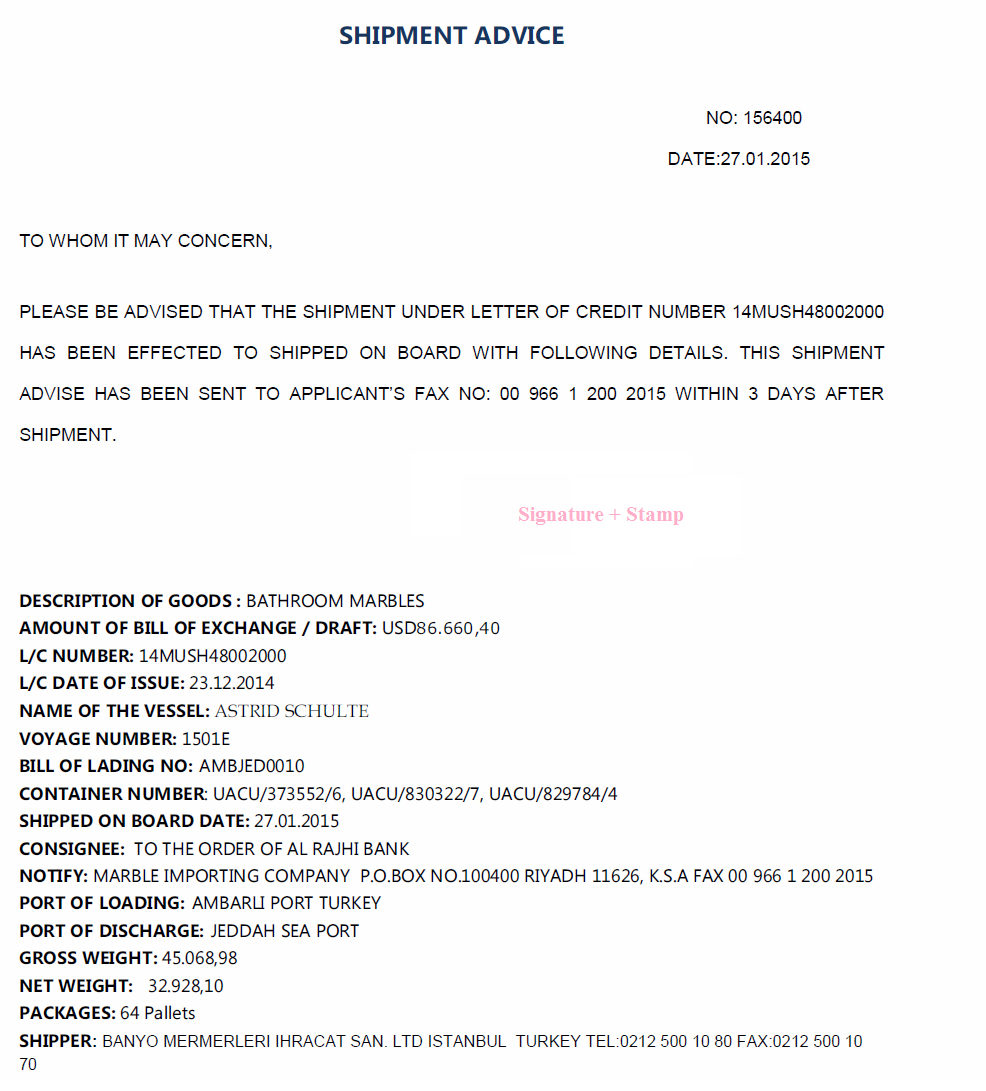A shipment advice is a commercial document , which is issued by the exporter, who is the beneficiary of the letter of credit, in order to give shipment details to the importer, who is the applicant of the letter of credit.
Who should issue shipment advice?
The shipment advice should be issued by the exporters.
When should the shipment advice be created and dispatched?
The shipment advice should be created as soon as the shipping details are available. In a letter of credit transaction, the shipment advice should be created and dispatched within 3 or 5 days after the date of shipment.
What is the function of a shipment advice or shipping advice in international trade transactions?
The main function of the shipment advice is to allow importers to arrange transport insurance in a timely manner.
Especially, this document is vital importance in situations where importers have to arrange the transport insurance, such as FCA, FOB, CFR, FAS, CPT and EXW deliveries.
A shipment advice informs the details of the shipments to the importer. By having the details of the shipment in advance,
- The importer could arrange the transport insurance. For example, if shipment has been made via sea shipment, the importer could arrange a marine insurance policy with the information he received from the shipment advice.
- The importer could track the shipment by using the necessary information that have been collected from the shipping advice. For example, the importer could track the container, if he knows either the container number or bill of lading number. Both of these two information could be gathered from the shipment advice.
- The importer could initiate import custom operations, if the exporter has supplied copy of shipment documents along with the shipment advice. In any case, the importer have to present original shipment documents to the custom authorities upon arrival of the goods.
What Sort of Information a Shipment Advice Should Contain?
A shipment advice should cover all the details of the shipment, so that the importer will be able to make the insurance coverage with the information provided by the advice of shipment only.
Below you can find the contents of the shipment advice along with explanations.
- Introduction: At the beginning of the shipment advice, a brief introduction paragraph should be placed. On the introduction paragraph, it would be advisable to mention the information as required by the letter of credit.
- Description of Goods: Description of goods should be mentioned on the shipment advice in accordance with the description of goods stated on the commercial inoice.
- Invoice Value of Goods: Total amount as shown on the commercial invoice should be mentioned on the shipment advice as well. This is an important part of the document, because this information is required for marine insurance coverage.
- Letter of Credit Number: If payment term is L/C, then letter of credit number should be stated on the shipping advice along with L/C Date of issue.
- Name of the Carrier: Irrespective of mode of transport, carrier’s name should be mentioned on the certificate of shipment.
- Name of Vessel and Voyage Number: In case of sea shipment name of vessel and voyage number should be indicated. In case of air shipment flight number and in case of land shipment plate number should be added to the certificate of shipment.
- Consignee and Notify Party: Consignee and notify party should be mentioned on the shipment advice as indicated on the transport document. (Bill of Lading, Air Waybill, CMR Transport Document etc.)
- Bill of Lading No: Together with the container number, bill of lading no lets importer to track the consignment. (in case of air shipments air waybill no, in case of land shipments CMR no can be written)
- Container Number: Together with the bill of lading no, container number lets importer to track the consignment.
- Shipped on Board Date: Shipped on board date evidences shipment date, which is a vital information for the insurance companies. (sea shipments)
- Seal Number: Seal number of the container. (sea shipments)
- Gross Weight: Gross weight of the consignment.
- Net Weight: Net weight of the consignment.
- Packages: Total number of packages as seen on the transport document.
- Shipper: Shipper company name as seen on the transport document.

